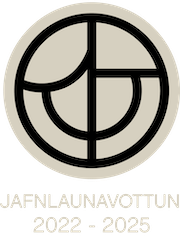Lífríki og búsvæði á Reykjaneshrygg - verkefni lokið
Fréttatilkynning verkefnisstjóra
Í verkefninu “Lífríki og búsvæði á Reykjaneshrygg” var mikilvægi Reykjaneshryggs sem búsvæði fyrir botndýralíf kannað. Hryggurinn var myndaður í eldsumbrotum og samanstendur af grófu landslagi með hörðum botni. Markmið verkefnisins var að fá betri innsýn inn í Reykjaneshrygginn sem búsvæði fyrir botndýralíf, með sérstaka áherslu á hverastrýtur á Steinahól sem liggur á 200 m dýpi.
Nýdoktor og verkefnisstjóri tóku þátt í margvíslegum verkefnum til að tryggja að markmið verkefnisins myndu nást. Hverastrýturnar á Steinahól voru kannaðar og kortlagðar í þrívídd með því að nota kafbát. Ein af niðurstöðum úr Evrópuverkefninu “A Trans-AtLantic Assessment and deep-water ecosystem-based Spatial management plan for Europe” (ATLAS), bentu til að aðstæður á Reykjaneshrygg væru óæskilegar fyrir margvíslegar tegundir kaldsjávarkórala, en æskilegar fyrir ýmsar tegundir fiska. Í verkefninu var beitt þróaðri aðferðarfræði til að búa til vísa til að meta ástand djúpsjávarvistkerfa á Reykjaneshrygg byggðum á sérfræðiþekkingu.
English:
The focus of the project “Fauna and habitats on the Reykjanes Ridge” was to explore the Reykjanes Ridge as a habitat for benthic fauna. The ridge has been formed by volcanic processes that have formed a rough landscape with a relatively large area of hard substrates. The goal of this project was to learn more about the Reykjanes Ridge as a habitat for benthic fauna, with a special focus on a hydrothermal vent system, Steinahól which lies at about 200-meter depth. The post-doctoral researcher and project leader took part in various work that ensured the project goal was achieved. Steinahóll hydrothermal vent systems were explored and mapped in 3-dimensions using a ROV. One of the findings in theEU Project “A Trans-AtLantic Assessment and deep-water ecosystem-based Spatial management plan for Europe” (ATLAS), that MFRI participated in was that the in the future, the Reykjanes Ridge, due to climate pressures,is predicted to become less suitable as a habitat for many cold-water coral species, but more suitable for some fish species.. A methodology was developed to determine the current environmental state of the Reykjanes Ridge based on indicators of environmental status that were chosen based on expert knowledge of deep-sea ecosystems.
Information on how the results will be applied:
Since its publication paper no. 4 has been cited about 100 times as this publication can be used for the scientific community to better understand the impact of large-scale ocean changes. Such information and information on how to implement environmental status estimates into management of deep-sea areas (paper no. 2) is now very relevant to the marine management community as the Montreal-Kumning agreement has been signed by most countries including Iceland and states that 30% of marine (and other) areas need to be managed and/or protected by 2030. The information created on Steinahóll hydrothermal vent systems is also highly important for protection. In the beginning of this project, the coordinates of the system were yet unknow but have now been established. The OSPAR convention calls for protecting hydrothermal vent systems in the deep ocean. Protection was established on the basis of the information gathered in collaboration with Dr. Saskia Brix and others.
A list of the project’s outputs:
∙ Publications
List publications, manuscripts and conference proceedings, PhD and MSc thesis resulting from the project. Report how publications are in accordance with the IRF’s open access policy.
Peer-reviewed scientific publication
No. 4
Morato, T., Pham, C. K., Fauconnet, L., Taranto, G. H., Chimienti, G., Cordes, E., Dominguez-Carrió, C., Durán Muñoz, P., Egilsdottir, H., González-Irusta, J.-M., Grehan, A., Hebbeln, D., Henry, L.-A., Kazanidis, G., Kenchington, E., Menot, L., Molodtsova, T. N., Orejas, C., Ramiro-Sánchez, B., … Carreiro-Silva, M. 2021. North Atlantic Basin-Scale Multi-Criteria Assessment Database to Inform Effective Management and Protection of Vulnerable Marine Ecosystems. Frontiers in Marine Science, 8, 255.
No. 3
Taylor, J., Devey, C., Le Saout, M., Petersen, S., Kwasnitschka, T., Frutos, I., ... & Brix, S. (2021). The discovery and preliminary geological and faunal descriptions of three new Steinahóll vent Sites, Reykjanes Ridge, Iceland. Frontiers in Marine Science, 1365.
No. 2
Kazanidis G, Orejas C, Borja A, Kenchington E, Henry LA, Callery O, Carreiro-Silva M, Egilsdottir H, Giacomello E, Grehan A, Menot L. 2020. Assessing the environmental status of selected North Atlantic deep-sea ecosystems. Ecological Indicators 119:106624
No. 1
Morato, T, González‐Irusta, J‐M, Dominguez‐Carrió, C, … Egilsdottir, H… et al. Climate‐induced changes in the suitable habitat of cold‐water corals and commercially important deep‐sea fishes in the North Atlantic. Glob Change Biol. 2020; 26: 2181– 2202.
All scientific peer-reviewed publications are open-access in line with RANNÍS policy.
Other publications:
• ECO Magazine
Kazanidis, G., Orejas, C., Borja, A., Kenchington, E., Rice, J., Henry, L. A., ... & Roberts, J. M. (2020). Achieving healthy and productive waters in the largest biome on earth. Environment Coastal and Offshore (ECO Magazine), 117-121.
http://digital.ecomagazine.com/publication/frame.php?i=683954&p=80&pn=&ver=html5
• Underwater ID guide for Steinahóll (Appendix 2) which was used for analysing of video/photographs by cruise/project participants during and after the 2018 mapping cruse to the Steinahóll hydrothermal vent region.
Heiti verkefnis: Lífríki
og búsvæði á Reykjaneshrygg/ Fauna and habitats on the Reykjanes Ridge
Verkefnisstjóri: Stefán Áki Ragnarsson, Hafrannsóknastofnun
Tegund styrks: Verkefnisstyrkur
Styrktímabil: 2017-2019
Fjárhæð styrks kr. 23.891.000
Tilvísunarnúmer Rannís: 174552


